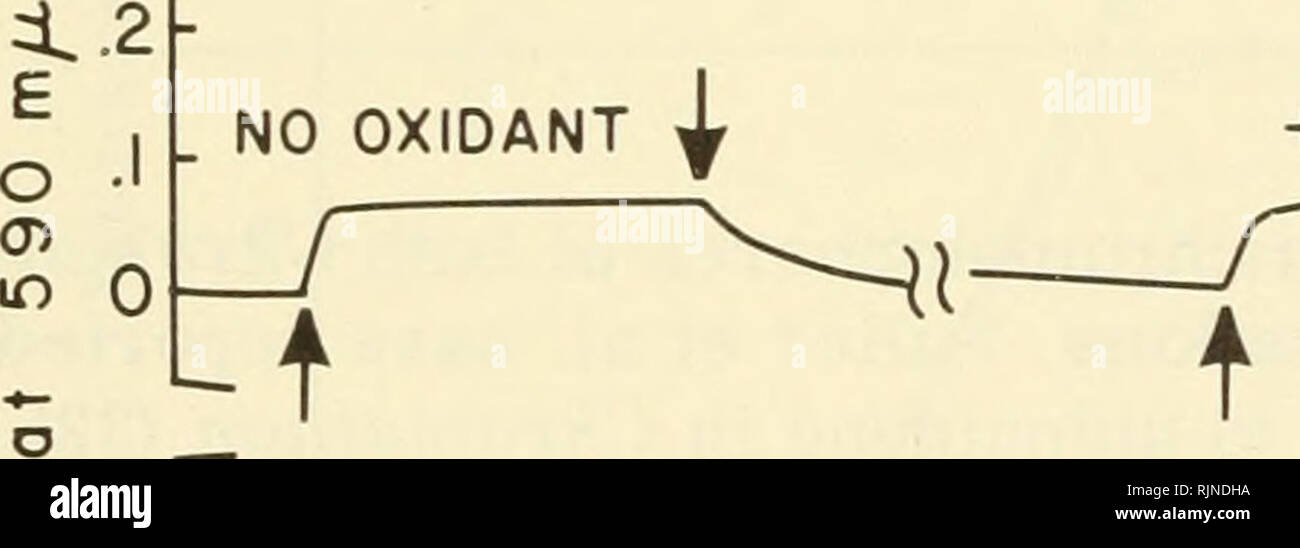. Bacterial photosynthesis. Bacteria -- Physiology; Photosynthesis. PHOTOOXIDATION AND PHOTOREDUCTION REACTIONS 245 The reason for the failure to show NAD reduction with Chromatium chromatophores is not immediately apparent. Arnon reported that he was able to obtain a photoreductionof NADin the presence of ascorbate and DPIP (30). In our laboratory, however, we have not been able to obtain a photo reduction of ISi AD with Chromatium chromatophores under any circumstance. This is surprising, since this bacterium would be expected to have an active system for NAD photo reduction, because it must

Image details
Contributor:
Library Book Collection / Alamy Stock PhotoImage ID:
RJNDHAFile size:
7.2 MB (117.2 KB Compressed download)Releases:
Model - no | Property - noDo I need a release?Dimensions:
2662 x 939 px | 22.5 x 8 cm | 8.9 x 3.1 inches | 300dpiMore information:
This image is a public domain image, which means either that copyright has expired in the image or the copyright holder has waived their copyright. Alamy charges you a fee for access to the high resolution copy of the image.
This image could have imperfections as it’s either historical or reportage.
. Bacterial photosynthesis. Bacteria -- Physiology; Photosynthesis. PHOTOOXIDATION AND PHOTOREDUCTION REACTIONS 245 The reason for the failure to show NAD reduction with Chromatium chromatophores is not immediately apparent. Arnon reported that he was able to obtain a photoreductionof NADin the presence of ascorbate and DPIP (30). In our laboratory, however, we have not been able to obtain a photo reduction of ISi AD with Chromatium chromatophores under any circumstance. This is surprising, since this bacterium would be expected to have an active system for NAD photo reduction, because it must reduce carbon dioxide via the photosynthetic route for all of its carbon compounds. Another photosynthetic bacterium, Rliodopseudomonas spheroides, was examined in the usual photooxidation systems with the results given in Fig. 9, Again, this organism showed the capacity to photo- oxidize DPIPH2 in a fast reaction which soon saturated in the usual manner. Like Chromatium, this bacterium did not have the ability to sustain the secondary coupled reactions with either NAD or fumarate, although there was a hint of a slow coupled reaction when fumarate was added to the system. In this case also, it was not possible to demonstrate directly a photoreductionof NAD when DPIP and an excess of ascorbate were present as the electron-donating system (31). The reason for inactivity in NAD reduction in the case of both Chromatium and Rliodopseudomonas spheroides is not known. One should probably look at the method of chromatophore preparation to see if inactivation of enzymes or other factors is involved in this situation.. D I . NO OXIDANT ^ LIGHT ON -«• ^>i LIGHT OFF + FUMARATE y r NAD 4''6 8 10 MINUTES 12 14 Fig. 9. Photooxidation of DPIPH2by Rps. spheroides chromato- phores. The experimental conditions given for Fig. 1 were em- ployed, except that Rps. spheroides chromatophores equal tc 0.110 jumoles of BChl per 4 ml were employed.. Please note that these images are extracted from